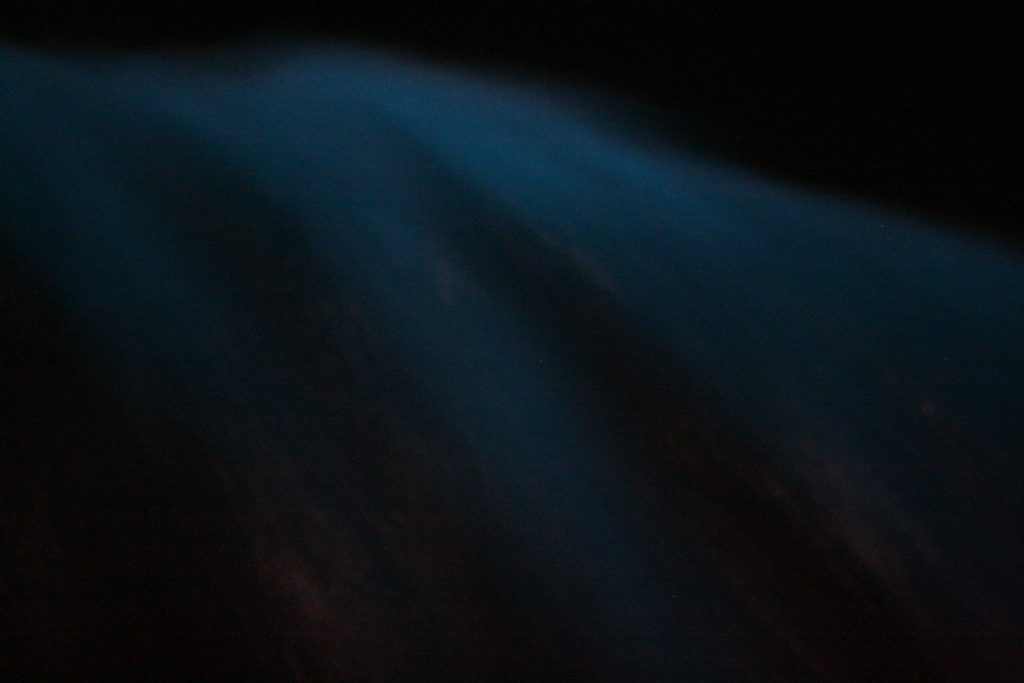Welsh waters set Richard Fleming aglow.

Bioluminescent wake, by Steven Isaacson on Flickr (licensed via Creative Commons)
The river was quite fast and as it dropped the boat was carried rapidly between a high clay bank on the outside of the bend and the shingle on the inside. I used the oars to keep us in the middle of the current as we moved past grazing cows high above us on the bank and wooded hangers on the slopes, on down towards the mouth of the river. At the estuary there were wide sands and mudflats. On one side a wooded hill rose from the rocks along the beach, on the other distant cottages. It was a day of early mists and building heat as we pulled the boat onto the sands and ran out a long rope and an anchor. We took the dark path through arched branches and out onto high rocky ground above the meeting where the Taf and the Towy and the Burry Inlet enter Carmarthen Bay. Hot air hazed Whitford point and Worms Head to the south. Gorse was in blossom. It almost always is, but it smells best with the sun on it, and best of all when there are butterflies and grasshoppers and suddenly around a bend a young fox.
From this prominence we could see almost to Dylan Thomas’s boathouse across the River Taf, and the other side of the dangerous Carmarthen sandbar the estuary and saltmarshes of North Gower. We sat in the sun looking at the patterns and shoals and channels where the three estuaries met, waiting for the sandbanks to disappear as the tide began to turn, to run the river backwards so that it would sweep our boat effortlessly back. We walked down through the woods and out onto the wide sands, and skirted a large mudflat, exposed by the falling tide and now sweating in the afternoon heat. The air was still, but the mudflat was ticking, and bubbling, and here and there hidden creatures were squirting jets of water. What might have seemed on any other day to be just a patch of mud was a noisy living thing, a matrix of creatures. Some were large worms, I guessed, or razor shells and cockles, all trying to cope with the low tide and the hot sun, but there were other smaller organisms too, just as there are fungi and bacteria and worms in the soil. The gulls and waders fed on the lugworms and the shellfish, and they fed on organisms too small for us to see, and the creatures that they filtered from the sea. This was not mud but something full of interconnected life, a complex living substance.
When the tide had crept beneath the boat we were washed back up the river and tied the boat above the high-tide line. We explored the beaches, and the castle, and a pub or two, until we found ourselves walking along a beach at midnight watching the waves light up as they broke upon the sand. It would have been easy to assume that they were reflecting moonlight, or some streetlight across the estuary. But I have been a fisherman and I knew different.
When I went out to my net on summer nights, I could catch hold of the float rope and tug at the net and the whole net would light up. Thousands of the tiny plankton creatures were resting on the meshes of the net. The shaking disturbed them and they sent out their bioluminescence so powerfully that I could see the fish shining in the net. So I knew why the waves were lighting up when as their crests broke and fell upon the sand.
We took our clothes off, of course, and walked into this living sea, and swam and maybe coiled around each other like eels and slithered a bit together and kissed and as we swam our hands and feet stirred up pools of cold planktonic light. I left the water first to see her walking out of the sea, but unexpectedly delighted that even as she walked up the beach her body was illuminated with tiny dots of phosphorescence from the creatures still clinging to her skin.
The sea will never again be just water, and mud never again just mud. Even soil will never again be just soil.
But the next night, when we brought our children to see the phosphorescence, it had gone.
*
Read Richard’s previous pieces for Caught by the River here. You can also follow him on Substack.